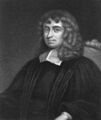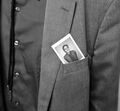May 4
Are You Sure ... (May 4, 2020)
• ... that Phantasmagoria was a form of horror theater which (among other techniques) used one or more magic lanterns to project frightening images such as skeletons, demons, and ghosts onto walls, smoke, or semi-transparent screens, and that some shows added sensory stimulation including smells and electric shocks with some shows requiring fasting, fatigue (late shows), and drugs to enhance the effect, and that the shows started under the guise of actual séances in Germany in the late 18th century, and gained popularity through most of Europe (especially England) throughout the 19th century?
• ... that the Canterbury scrying engine is a relatively simple device for a cathedral the size of Canterbury, yet the engine's narthex kernel can ring the changes on theological algorithms to Six Sigma quality control specifications?
• ... that physician, patent examiner, and inventor Charles Grafton Page (1812–1868) investigated and exposed fraudulent Spiritualists (such as the Fox sisters, writing: "The prime movers in all these marvels are impostors, and their disciples, dupes. While the former are filling their coffers at the expense of the latter, they must often indulge in secret merriment at the credulity of their adherents, and particularly at the grave discussions of the learned clergy and others upon electricity, magnetism the new fluid... or the devil's immediate agency.... The instant the idea of the superhuman gets possession of the mind all fitness for investigation and power of analysis begins to vanish, and credulity swells to its utmost capacity. The most glaring inconsistencies and absurdities are not discerned and are swallowed whole ...."?
On This Day in History and Fiction
1677: Mathematician and theologian Isaac Barrow dies. Barrow played an early role in the development of infinitesimal calculus: he was the first to calculate the tangents of the kappa curve.
1733: Mathematician, physicist, and sailor Jean-Charles de Borda born. He will contribute to the development of the metric system, constructing a platinum standard meter, the basis of metric distance measurement.
1825: Biologist Thomas Henry Huxley born. He will be known as "Darwin's Bulldog" for his advocacy of Charles Darwin's theory of evolution.
1859: Mathematician and logician Joseph Diez Gergonne dies. He contributed to the principle of duality in projective geometry, by noticing that every theorem in the plane connecting points and lines corresponds to another theorem in which points and lines are interchanged, provided that the theorem embodied no metrical notions.
1921: Physicist Harry Daghlian born. He will be fatally irradiated in a criticality accident during an experiment with the Demon core at Los Alamos National Laboratory.
2019: Photograph of Karl Jones taken by Steve Ozone.






